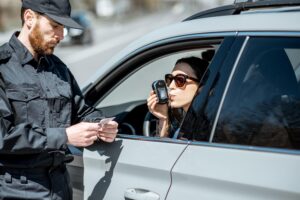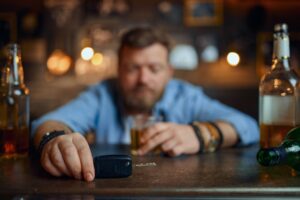We all know that drinking and driving is a bad decision, yet it is a problem that confronts us year after year. Drinking and driving causes crashes that are numerous, serious, preventable—and are expensive in terms of money, time, and lives lost.

The statistics
The statistics are astounding: “Every day, about 37 people in the United States die in drunk-driving crashes — that’s one person every 39 minutes,” as reported by the National Highway Traffic Safety Administration (NHTSA). According to the NHTSA, there were 13,384 deaths from crashes involving drunk drivers in 2021, which is a 14% increase from the previous year.
Alcohol intoxication is measured by looking at a person’s Blood Alcohol Concentration, or BAC, which is the percent of alcohol in a person’s bloodstream. Across the United States (including Washington, D.C. and Puerto Rico), for people of legal drinking age, it is illegal to drive with a BAC of 0.08 or higher. In Utah, a person of legal drinking age cannot legally drive with a BAC above 0.05. The requirements are even stricter for people who are less than 21 years old, and many states have zero-tolerance policies for people who choose to drive after drinking under the legal age limit. In Virginia, for example, a person who is under 21 cannot legally drive if his or her BAC is 0.02 or above.
Driving after drinking within the legal limits can also be deadly. In 2021, there were 2,266 people killed in alcohol-related crashes where a driver had a BAC of 0.01 to 0.07 (within the legal limit).
The reason for the prohibition against drunk driving is clear: Alcohol impairs your reasoning and memory and can impact your reaction time even in levels as low as 0.04. As a person’s BAC increases, it becomes more and more likely that he or she will be involved in a crash if that person makes the decision to drive while intoxicated. Drunk driving can lead to arrests, crashes, or even death.

The sobriety testing
When police respond to a crash involving a person suspected of drunk driving, the officer will administer a field sobriety test, which often consists of three components:
- Horizontal gaze nystagmus
- One-leg stand test
- Walk-and-turn test
A driver who cannot successfully complete the field sobriety test will be asked to consent to a Preliminary Breath Test or PBT. This test requires the suspected drunk driver to blow into the “straw” of a handheld device that can measure BAC. If the device confirms that the driver’s BAC is above 0.08, the officer now has the requisite probable cause for a driving while intoxicated (DWI) or driving under the influence (DUI) arrest. After the driver is charged with the appropriate alcohol-related offense, the officer will transport that person to the police precinct for additional testing.

The criminal case
All criminal defendants have the right to plead guilty, no contest (nolo contendere), or not guilty to crimes or traffic infractions. However, the plea that an accused drunk driver enters into in criminal court will have implications for the related civil trial.
If a defendant pleads not guilty, disputes the drunk driving accusation, and is ultimately convicted of driving while intoxicated, evidence of his not guilty plea cannot be used against him for purposes of the civil trial. On the other hand, if a defendant pleads guilty or no contest to the criminal drunk driving charge, evidence of his guilty or no contest plea is admissible at the civil trial related to the crash.
This is because the courts interpret a guilty or no contest plea as a “judicial admission” of guilt or wrongdoing since a defendant must swear or affirm to tell the truth before entering the plea. However, the civil trial judge will likely give the defendant a chance to explain his or her reason for pleading guilty at the related criminal hearing.
In most jurisdictions in Virginia, police officers are equipped with a body-worn camera, which is affixed to the outside of an officer’s uniform. (This is not true for Virginia State Police Troopers.) The footage from the field sobriety test is generally admissible in both the criminal and civil trials because it depicts the defendant and was recorded close to the alcohol-related crash. The results of a PBT are inadmissible at trial, but evidence of the drunk driver’s BAC can be proved with a Certificate of Analysis from the police precinct. Remember that the officer transports the drunk driver to the police precinct for additional testing if the PBT showed that the driver’s BAC was greater than 0.08.

The civil case
You know now that the defendant’s plea from the criminal trial, the camera footage depicting the field sobriety test, and the Certificate of Analysis showing BAC can be admitted into evidence at the related civil trial and help to prove the civil case. If the Certificate of Analysis shows that the drunk driver’s BAC was above 0.15, there are additional implications in civil cases in Virginia.
A defendant who was intoxicated at the time of a crash could be subjected to punitive damages if his or her Blood Alcohol Concentration (BAC) was 0.15 or greater, OR if the defendant refused to submit to a BAC test. NHTSA and Stanford University associate the following characteristics with a person who has a BAC of 0.15:
- Blurred vision
- Far less muscle control than usual
- Vomiting
- Major loss of balance
- Onset of dysphoria (anxiety and restlessness)
- Poor balance, speech, vision, reaction time, and hearing
- Substantial impairment in vehicle control, attention to driving task, and in necessary visual and auditory information processing
From a legal perspective, an elevated BAC suggests that the drunk driver engaged in behavior that was so reckless or so negligent, that it demonstrated a conscious disregard for the rights of others. In other words, a person who makes the decision to drive when his or her BAC is 0.15 is obviously endangering not only their own life, but the lives of everyone else on the road. Because this behavior is so extreme, it is treated differently by our legal system.

The general goal of our justice system is rehabilitation. Punitive damages, on the other hand, seek to punish the wrongdoer and discourage other members of our society from engaging in similar conduct. Punitive damages are generally discouraged and reserved for extreme behavior—like driving with a BAC above 0.15. For a civil case, the inclusion of punitive damages allows an injured person to recover not only for their own economic losses and pain and suffering, but to also send a message to a drunk driver whose intoxication lead to an inevitable and preventable injury.
If you have been injured due to the negligence or intoxication of another driver, you may be entitled to compensation. Call Allen and Allen today for a free case evaluation at 866-378-2724.



